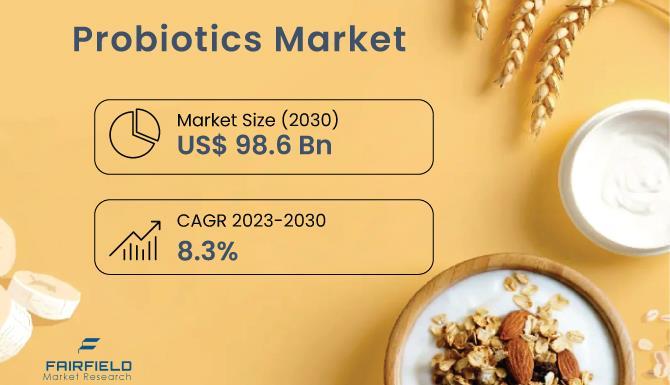Probiotics Market

The global probiotics market is set for substantial growth, with its valuation anticipated to leap from USD 52.1 billion in 2022 to USD 98.6 billion by 2030. This represents a robust compound annual growth rate (CAGR) of 8.3% from 2023 to 2030.
For More Industry Insight: https://www.fairfieldmarketresearch.com/report/probiotics-market
Key Market Drivers
1. Increased Demand for Skin Health Probiotics: There is a rising trend towards integrating probiotics into skincare products, driven by a growing preference for holistic health solutions. Consumers are seeking products that enhance both internal and external skin health.
2. Probiotics in Sports Nutrition: Athletes are increasingly recognizing the benefits of probiotics for gut health, which is crucial for nutritional absorption, energy production, and immune function.
3. Challenges in Product Viability: Maintaining the potency and viability of probiotic strains throughout the product's shelf-life remains a significant challenge. Ensuring consistent quality and effectiveness is crucial for market growth.
Market Trends and Insights
• Lactobacilli Dominance: In 2022, the lactobacilli segment was the market leader due to its role in boosting the immune system and reducing allergy and infection risks.
• Probiotic Food and Beverages: This segment was the largest in 2022, with probiotics increasingly added to dairy-free products like almond milk yogurt and coconut milk kefir, catering to vegan and lactose-sensitive consumers.
• Animal Probiotics: Expected to be the fastest-growing category, animal probiotics are used to support immune health and manage stress in animals, especially during weaning and transportation.
Regional Analysis
• Asia Pacific: Expected to dominate the probiotics market, driven by increased digestive health issues due to Western eating habits and a growing awareness of probiotics. China and Japan are key markets, with Australia and New Zealand showing significant economic growth.
• North America: Predicted to be the fastest-growing region, with a well-established market for functional foods and beverages. The region benefits from robust R&D and regulatory frameworks ensuring product quality and safety.
Challenges and Barriers
• Scientific Understanding: There is a need for more precise scientific understanding of probiotic strains and their health benefits, as current research can be inconsistent and lacking in long-term studies.
• High R&D Costs: The significant expense involved in developing new probiotic strains can limit innovation and make it difficult for smaller companies to compete.
Opportunities and Future Outlook
1. Personalized Probiotics: Tailored probiotics for specific health issues are gaining traction, with potential for increased consumer engagement and brand loyalty.
2. Probiotics in Mental Health: Growing awareness of the gut-brain axis is leading to increased use of probiotics for mental health issues such as anxiety and depression.
3. Plant-Based Probiotics: As plant-based diets become more popular, plant-based probiotics are emerging as a key market segment, catering to vegans and those with lactose intolerance.
Regulatory Environment
• FDA and Global Standards: Probiotics are regulated as dietary supplements or food ingredients, with regulations affecting labeling and safety in various regions including the U.S., EU, Canada, and Australia. Stricter regulations could impact marketing and product claims.
Competitive Landscape
The global probiotics market is dominated by a few major players who are continuously innovating and expanding their product offerings. The focus on developing new probiotic strains and enhancing distribution networks is critical for maintaining a competitive edge.
